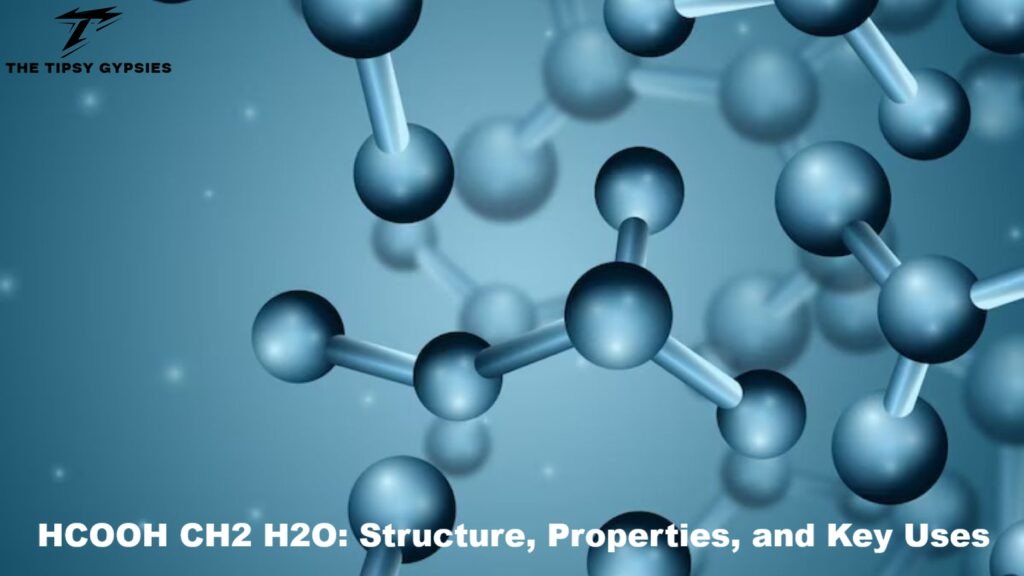HCOOH CH2 H2O is not a single molecule. It is a shorthand expression for three different chemical components that often interact in laboratories and industries. HCOOH is formic acid, the simplest carboxylic acid. CH2 is usually a methylene group, an important building block in organic chemistry, though in special cases it can mean a reactive carbene. H2O is water, nature’s most universal solvent and a key participant in countless chemical reactions.
When these three are mentioned together, they often describe a reaction system involving acid-base chemistry, hydrolysis, esterification, polymer chemistry, or hydrogen generation. This combination is important for both scientific research and large-scale industrial production.
Breaking Down the Components of HCOOH CH2 H2O
Formic Acid (HCOOH) – The Simplest Carboxylic Acid
Formic acid is a clear liquid with a distinct, pungent odor that is instantly recognizable in concentrated form. It occurs naturally in ants, bees, and some plants. In industry, it is mainly made by hydrolyzing methyl formate or by reacting carbon monoxide with water in the presence of a catalyst.
The acid group (-COOH) makes it an excellent proton donor in water, which allows it to work as a reactant in esterification, a reducing agent in synthesis, and a preservative because of its antibacterial properties.
Formic acid has a unique property of forming an azeotrope with water at about 77.5% concentration, boiling at 107.3°C. This detail is very important for separation and purification processes.
Methylene (CH2) – The Carbon Connector
CH2 refers to the methylene group, made up of one carbon atom bonded to two hydrogen atoms.. It cannot exist on its own under normal conditions and is always part of a larger molecule. In polymers, methylene groups form the backbone structure, which affects flexibility, melting point, and reactivity.
In advanced reactions, CH2 can mean methylene carbene, a short-lived and very reactive form. It can add to double bonds, start polymerization, or rearrange molecules. In most practical cases, methylene units come from methanol (CH3OH) or formaldehyde (CH2O).
Water (H2O) – The Universal Solvent and Reactant
Water is the most widely used chemical in science and industry. In HCOOH CH2 H2O systems, water can be:
- A solvent: dissolving chemicals and helping them react faster.
- A reactant: directly taking part in reactions like hydrolysis or hydration.
- A product: formed in condensation reactions such as esterification.
In acidic solutions, water helps keep the balance between reactants and products. Its polarity and ability to form hydrogen bonds make it essential in both organic and inorganic chemistry.
Chemical Significance of HCOOH CH2 H2O
When formic acid, methylene, and water are present together, they can take part in several chemical processes such as:
- Hydrolysis: breaking esters or amides into acids and alcohols/amines.
- Esterification: is a reaction where an acid combines with an alcohol to form an ester and water as a byproduct.
- Redox chemistry: where formic acid can act as a reducing or oxidizing agent.
- Polymer chemistry: where methylene chains interact with acidic or water-based conditions to create functionalized polymers.
Their combined presence usually means the system is chemically active with the potential for important transformations.
Industrial and Laboratory Applications
Formic Acid in Manufacturing
Formic acid’s strong acidity and reducing ability make it valuable for:
- Leather tanning: stabilizing proteins in hides.
- Textile finishing: adjusting acidity and fixing dyes.
- Rubber coagulation: helping in latex processing.
- Preservation: preventing bacterial growth in animal feed.
In these cases, water is often used to dilute the acid, while methylene-based compounds may be part of the reaction or serve as solvents.
Synthesis of Methyl Compounds
When formic acid reacts with methanol, it produces methyl formate:
HCOOH + CH3OH ⇌ HCOOCH3 + H2O
This reaction is a classic esterification. The reverse process, hydrolysis, regenerates formic acid and methanol, usually with the help of an acid catalyst.
Fuel Cell and Hydrogen Storage Applications
Formic acid is being studied as a liquid hydrogen carrier for fuel cells. Its breakdown:
HCOOH → H2 + CO2
can be done under mild conditions, making it a promising clean energy option. In water-based systems, methylene-containing catalyst structures can help improve hydrogen release speed and reaction efficiency.
Key Reactions Involving HCOOH CH2 H2O
Esterification
Formic acid reacts with methanol and other methylene-containing alcohols to produce esters, with water as a byproduct. Removing water or using excess alcohol drives the reaction toward ester production.
Hydrolysis
The opposite of esterification, hydrolysis uses water to break esters into their acid and alcohol components. This reaction can be speeded up by adding acid or base.
Formaldehyde Generation
Under certain conditions, formic acid and methylene compounds can produce formaldehyde (CH2O), which is important in resin production and plastic manufacturing.
Environmental and Safety Considerations
Handling Formic Acid
Formic acid is corrosive and can cause burns or breathing problems. Always:
Work in a well-ventilated area.
Wear acid-resistant gloves and safety goggles.
Store in corrosion-proof containers.
Waste Management
Processes involving HCOOH CH2 H2O can produce VOCs and CO2. Waste should be treated carefully to avoid air and water pollution, and disposal must follow environmental safety laws.
Role in Analytical and Research Work
In analytical chemistry, formic acid-water mixtures are used in liquid chromatography to control pH and improve separation efficiency. Methylene-containing compounds can affect the separation by changing the polarity or reactivity of samples.
In spectroscopy, these three components can change IR absorption peaks, NMR shifts, and UV-Vis readings, which helps chemists understand molecular structures and reaction progress.
Future Research and Innovations
Work on HCOOH CH2 H2O systems is expanding in:
- Green chemistry focuses on producing formic acid and methanol from renewable biomass sources to reduce environmental impact.
- Catalyst design creating better catalysts for faster, cleaner reactions.
- Energy storage improving formic acid-water systems for portable hydrogen fuel cells.
These developments could make chemical processes safer, more efficient, and eco-friendly.
Conclusion
The mix of formic acid, methylene, and water is more than just a set of chemicals. It is a core part of important industrial and laboratory processes, from fuel cells to polymer chemistry.
Understanding how each component works and how they interact helps chemists, engineers, and researchers design better, safer, and more sustainable chemical processes.
Frequently Asked Questions ( FAQs )
What is HCOOH CH2 H2O?
HCOOH CH2 H2O is a chemical shorthand for three separate components: HCOOH (formic acid), CH2 (methylene group or carbene), and H2O (water). They often appear together in reactions such as esterification, hydrolysis, and hydrogen production.
Is HCOOH CH2 H2O one compound?
No. It is not a single compound. It represents three distinct chemicals that may be present or react together in the same system.
Where is HCOOH CH2 H2O used?
This combination is used in leather tanning, textile processing, rubber manufacturing, methyl formate synthesis, fuel cell hydrogen storage, and various laboratory experiments.
What is the main reaction between HCOOH and H2O?
The most important industrial reaction is the hydrolysis of methyl formate:
HCOOCH3 + H2O → HCOOH + CH3OH.
It produces formic acid and methanol.
Is formic acid safe to handle?
Formic acid is corrosive and can cause skin burns or breathing problems. Always handle it with protective gloves, goggles, good ventilation, and store it in acid-resistant containers.






